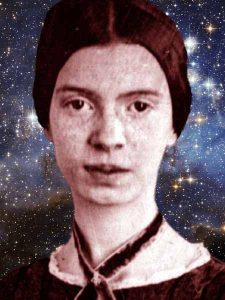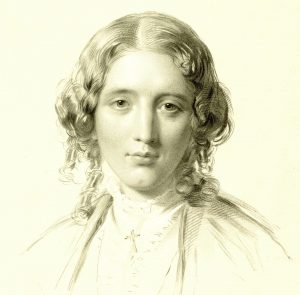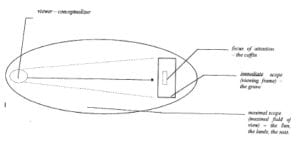 “My Business is Circumference”
“My Business is Circumference”
Sometime in July 1862, Dickinson wrote her fourth letter (L268) to Thomas Wentworth Higginson, which includes several notable revelations. Such as her quirky description of herself, in the absence of a portrait Higginson asked her to send, and her statement of an important principle of her poetic practice, which people who read the poems for biographical hints often ignore:
When I state myself, as the Representative of the Verse – it does not mean – me – but a supposed person.
Most importantly, in the middle of a long paragraph in which Dickinson invokes surgeons setting broken bones, calls Higginson “Preceptor,” and promises him “Obedience,” she asserts rather curtly:
Perhaps you smile at me. I could not stop for that – My business is circumference.
Startling in its assurance, this declaration is an expression of Dickinson’s poetics.
This week, we will explore just what this “business” of “circumference” is and means in Dickinson’s poetry and letters. Originally a term from geometry, circumference is an idiosyncratic and paradoxical concept Dickinson invokes in many of her most challenging poems. A figure of both enlargement and limitation, circumference is a foundation for knowledge, language, and experience of the divine.
Scholars have considered circumference in relation to the Transcendental and Romantic sublime, Christian mysticism, feminine mythology and archetypal psychology, existential theology, the rhetorical figure of catachresis, and as part of Dickinson’s terrestrial and geographical imaginary. In our discussions, we will examine Dickinson’s fourth letter to Higginson, its signal disclosures, and her growing relationship to this crucial correspondent.
“The Greatest, Wisest and Meanest of Nationkind”
Springfield Republican, July 19, 1862
Progress of the War, page 1
“There has been no new movement by Gen. McClellan’s army during the week, but all the accounts from the James River indicate that the offense which succeeded the week of battles is soon to be broken. What the plan of attack may be is not yet developed, but it is evident that the fleet is to play an important part in the grand movement.”
The General Situation, page 1
“There is no doubt that the strength of the government and the country has been to some extent neutralized by political discussion. War has been made on our generals because of their party politics, and the public mind has been distracted by irrelevant questions, to the neglect of what should have the whole attention and energy of the people.”
A Summer in Europe, page 2 [letter from Samuel Bowles]
“These excursions through England and her adjacencies and this residence in her capital of course yield abundant material for more descriptions and comments and criticisms. Perhaps I may sum up England with the sarcasm of Macauley, or Sidney Smith, or somebody else, or her greatest philosopher and statesman (Lord Bacon), and say she is at once the greatest, wisest and meanest of nationkind.”
Original Poetry:
“Homeless” by Adelaide A. Proctor (excerpt), page 6
Nay; — goods in our thrifty England
Are not left to lie and grow rotten
For each man knows the market value
Of silk or woolen or cotton.
But in counting the riches of England
I think our Poor are forgotten.
Books, Authors and Art, page 7

“A recent reviewer says of Mrs. Stowe that her descriptions of negro life and character have never been surpassed. This is high praise, but scarcely deserved. The very redundancy of her genius, more creative than imitative, leads her to make of her prominent characters the mouth-pieces to utter her own rich thoughts. She has seized upon the externals of the colored race, picturesque in their misery, and breathed though them a vitality not wholly African, but bearing many traces of Anglo-Saxon origin.”
Hampshire Gazette, July 22, 1862
page 2
“An important war bill has been passed by Congress. It gives the President powers to call out the militia in sufficient numbers to crush out the rebellion at once.”
“You Must Banish Me”
In his account of Dickinson’s letters to Higginson, Jason Hoppe argues:
It is in her fourth letter to him that Dickinson appears finally to accept whatever assent Higginson has voiced to her proposal, pronouncing that if he really does “truly consent,” she will be “happy to be [his] scholar, and will deserve the kindness, [she] cannot repay” (L 268).
Although we cannot know for sure, in the absence of his responses, it appears that Higginson has been reading the poems Dickinson encloses in her letters and critiquing them—that is, he is acting like her “Preceptor” in the literary art of poetry. However, it is interesting to note that in this letter, as in earlier letters, Dickinson describes this tutelage in melodramatic terms of curing her illness or performing “surgery” and setting her fractured bones. Her pledge of “Obedience” to Higginson also seems overblown, since in the very next sentences, Dickinson tells him, in no uncertain terms, what her “Business” is — “Circumference.” As if startled by her own boldness, she then acknowledges that he has “business” too, and offers him a release clause, which has a whiff of masochism about it:
Because you have much business, beside the growth of me – you will appoint, yourself, how often I shall come – without your inconvenience. And if at any time– you regret you received me, or I prove a different fabric to that you supposed – you must banish me.
Theirs is an intricate minuet of need, power, and recognition. Thus, it is not surprising that Dickinson would announce her central occupation of Circumference to this eminent literary figure. Around the same time, in the summer of 1862, Dickinson wrote to her friends, Elizabeth and Josiah Holland, in similar though more conventional terms:
Perhaps you laugh at me! … My business is to love.
And later in the same letter, in the voice of a bird,
My business is to sing (L269; see the post on this letter).
Josiah Holland was also a well-known literary editor and writer, but an intimate and friend, not a “Preceptor,” not someone Dickinson necessarily saw in the role of mentor.
And Circumference is a more elusive, even ambitious, occupation than loving or singing, which were the expected province of “poetesses” of the time. Dickinson’s Webster’s lists three definitions of the word, all of which refer to or quote from the work of epic poet John Milton, giving it quite a bit of gravitas:
1. The line that bounds a circle; the exterior line of a circular body; the whole exterior surface of a round body; a periphery. – Newton. Milton.
2. The space included in a circle. – Milton. Dryden.
3. An orb; a circle; any thing circular or orbicular; as in Milton, speaking of a shield, The broad circumference / Hung on his shoulders like the moon.
The word appears in 17 poems throughout Dickinson’s canon, but the notion of Circumference and its attendant ideas—circuit, periphery, limitation, boundary, circles (crowns), arcs (diadems, crescents), transcendence—permeate many more. The word also appears in six letters: in Letter 269 from 1862, mentioned above, a year of intense productivity for Dickinson, and then much later in a letter in 1881 and four in 1884, two years before her death.
Reflection
Ewa Chrusciel
 When Emily Dickinson sent her poems to Thomas Wentworth Higginson – a writer for Atlantic Monthly – she asked whether her verse was alive.
When Emily Dickinson sent her poems to Thomas Wentworth Higginson – a writer for Atlantic Monthly – she asked whether her verse was alive.
What does the semblance of felt life have to do with Dickinson’s “circumference”? Could Dickinson’s desire for her verses to be alive also have something to do with circumference? Furthermore, what does circumference have to do with the human mind, processes of thinking, and an epiphany?
The poem “A Coffin – is a Small Domain” (F890B, J943), dated to 1864 and so not included in the poems for this week, will help us lay the foundation of circumference, as defined in relation to other containers.
A Coffin – is a small
Domain,
Yet able to contain
A Citizen of Paradise
In it's diminished Plane –
A Grave – is a restricted
Breadth –
Yet ampler than the Sun –
And all the Seas
He populates –
And Lands He looks opon
To Him who on it's
small Repose
Bestows a single Friend –
Circumference without Relief –
Or Estimate – or End –
As the poem progresses with a rising gradation of bounded spaces, the unbounded spaces also keep expanding. A coffin and grave seem to be in almost a binary juxtaposition to Circumference and Relief. Geometrically speaking, we have rectangular shapes juxtaposed with circular spaces and out of this juxtaposition the new dimension emerges – the third space of circumference.
Circumference is always in motion, ever expanding. This state of ever expanding in Dickinson’s poetry is indispensable to liberation from static containers. In a sense, circumference becomes a container for eternity in time and infinity in space.
Liberation from static and bounded containers requires undertaking a journey. LIFE AS A JOURNEY is one of the most basic conceptual metaphors. However, Dickinson goes beyond a linear progression, which a standard journey would imply. For her, a voyage becomes not earth-bound, but boundless in outer space of circumference. As cognitive scholar Margaret Freeman suggests, Dickinson restructured a linear and temporal journey into a circular, spatial one. Freeman writes,
in a cyclical universe, the geographical metaphors of goal, location as up or end have no physical, bodily grounding, with the consequence that it no longer makes sense to speak of “destination after” death.
Here is my pictorial representation of the container metaphors in “A Coffin — is a small Domain:”
 To borrow a bit from cognitive linguistics, we could claim that the circumference is located at the periphery of our view.
To borrow a bit from cognitive linguistics, we could claim that the circumference is located at the periphery of our view.
 The circumference is presented in this picture on a periphery. It is consistent with one of the definitions included in Webster’s Dictionary: a periphery. Visually, it also resembles an arc, which is also congruent with the definition in Dickinson’s Lexicon in reference to “A Coffin — is a small Domain:”
The circumference is presented in this picture on a periphery. It is consistent with one of the definitions included in Webster’s Dictionary: a periphery. Visually, it also resembles an arc, which is also congruent with the definition in Dickinson’s Lexicon in reference to “A Coffin — is a small Domain:”
Infinite lines, planes, degrees, arcs, angles, diameters, projections, intersections and repetitions of circles; [fig.] the infinite dimensions of life, reality, existence.
Conceptually, it can also be associated with a rainbow and the Biblical promise of resurrection and eternal life.
In my understanding, circumference is an epiphany, because it is never static or stable, an always emergent and incipient third space. The epiphany is alive. Perhaps such circumferential progression inward signifies the fourth dimension, a concept discussed by H.G. Wells and explored by Picasso and Braque in their cubist paintings, which restructures the linear and temporal movement into a circular and spatial orientation.
In order to attain such an epiphanic and circumferential state, one has to abandon his/her daily orbit of vision and enter
an orbit coterminous with longing,
as Seamus Heaney says in his poem “Wheels Within Wheels.” Perhaps this intuitive comprehension, or in other words, tacit knowing has some ties with Dickinson’s understanding of circumference and epiphanic cognition. I would venture to say, however, that Dickinson’s notion of epiphany anticipated modern epiphany, which relies on image rather than vision. It also anticipated the modern imagination, what Wallace Stevens calls
the power of the mind over the possibilities of things.
Sources
Freeman, Margaret. "Metaphor Making Meaning: Dickinson’s Conceptual Universe. " Journal of Pragmatics 24, 6 (December 1995): 643-666.
Stevens, Wallace. The Collected Poems. New York: Vintage, 1990, 136.
bio: EWA CHRUSCIEL is a bilingual poet and a translator, born in Poland. Her three books in English are Of Annunciations (Omnidawn Press, 2017), Contraband of Hoopoe (Omnidawn Press, 2014) and Strata (2011). She has also published three books in Polish: Tobo ek (2016), Sopi ki (2009), Furkot (2001). She is an associate professor of creative writing and poetry at Colby-Sawyer College in New Hampshire.
Sources
History
Hampshire Gazette, July 22, 1862
Springfield Republican, July 19, 1862
Biography
Hoppe, Jason. “Personality and Poetic Election in the Preceptual
Relationship of Emily Dickinson and Thomas Wentworth
Higginson, 1862-1886.” Texas Studies in Literature and Language 55. 3 (Fall 2013): 348-38, 359-60.



Of all the research on circumference you bring up in your intro, Eniko Bollobas’s resonates most with me. The cognitive linguistic approach I use in tackling these poems is for me a catachresis as well. I use it because I want to find imperfect words for this tacit and ineffable phenomenon of circumference. So all these attempts to trace it and describe it are subservient and secondary to the presence – lived and felt life in ED’s poems. The presence of circumference – the tacit understanding we all have of it – supersedes our attempt to analyze it. The more I want to grasp it (via drawings, and cognitive linguistic tools or the neurological theories), the more horizon recedes in a sense.
Cognitive poetics scholar, Reuven Tsur, in Toward a Theory of Cognitive Poetics, calls such poetry a “poetry of disorientation” and claims that a reader develops an adaptation device relevant to such poetics called “emotional disorientation.” He writes, “ When the reader in a mannerist age contemplates such disorienting qualities as surprise, perplexity, startling, or astounding effects, or similar things associated with sensuous metaphors or metaphysical puns and conceits, far from having a painful experience, he may derive pleasure from the recognition that he is well equipped with the cognitive equipment required for coping with a reality in which the regular orientation devices are of little use.” I tend to place ED with metaphysical poets, because I think she knew the power of conceit.
Further, Tsur writes, “In poetry of any kind there is always a balance between elements that undermine the reader’s sense of control and certainty, and those that increase them. If a writer uses an element that disturbs the reader’s sense of control (like delaying comprehension in some ways), s/he will have to balance it by supporting the reader’s sense of control by other means (like rhythmic order), or get a different point of balance. ”
I think ED often has this trajectory: strong gestalt into weak gestalt. In other words, the containers are bounded and they become unbounded as the poem progresses and at the periphery of that unboundedness – we find circumference.
In “I felt a funeral in my brain” (F340 J280), for example, the pulsation of the brain, the heart beat, and “the ear beat” merge, reaching such intensity (“Kept beating – beating – till I thought/ My Mind was going numb –“) that they break into “Silence” in the fourth stanza. To use Tsur’s term, “cognitive overload” takes place which might either lead to the collapse of consciousness and the undifferentiated mass of gestalt-free vision, but also to an altered state of consciousness which in the poem is expressed through the sense of breaking through, of dropping down, and the collapse of knowledge.
I think that altered state of consciousness and what goes beyond any knowledge is what ED was interested in.
Ewa Chrusciel